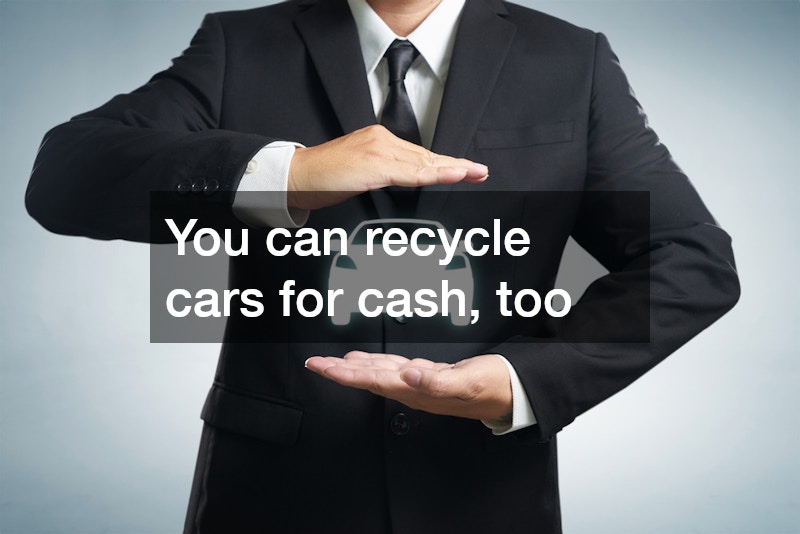
When most people think of recycling, tin and aluminum cans, plastic bottles, and newspapers come to mind. You can recycle cars for cash, too. Called car scrapping, the term refers to selling a vehicle for its parts or selling it as scrap metal. Many auto disposal lots, also referred to as pull-apart lots, buy totaled vehicles, then remove the salvageable parts to resell. Scrap metal lots also remove parts for salvage, but they compact the scrapped cars and then sell the scrap metal.

These two options offer a viable way to get rid of old cars and still get great use out of them. A third, lesser-known vehicle recycling option exists, too. Some auto shop teachers purchase old or totaled vehicles to use as project vehicles in their classes. You can use this method, as long as you can legally sell the vehicle with a salvage title and find an interested teacher or mechanic.
Other Unique Recycling Opportunities
You can recycle far more than cars, trucks, SUVs, vans, and minivans. From storage containers to tires, many unique recycling opportunities can earn you money. Some individuals find recycling their first load so lucrative that they start a side business. According to Profitable Venture, the following recycling businesses cost little to nothing to start and can earn a quick profit:
• Tire recycling
• Rubber recycling
• Natural rock sales (to landscaping firms)
• Scrap metal sales
• Sawdust recycling
• Glass recycling
• Cardboard recycling.

If one item won’t produce enough recyclables for weekly earnings, try collecting a different item each day of the week, such as tires on Monday, metal on Tuesday, glass on Wednesday, etc.

Recycling is vital to mitigate environmental degradation and avoid unnecessary waste. Some of the 4 materials that can be recycled include plastics, cardboard, concrete, electronic devices, and wood. If you are captivated by learning more about who picks up recycling and the processes involved in recycling, it is advisable to visit the closest recycling center near you.
Construction sites are renowned for producing huge waste, more so concrete and other building materials. If not properly disposed of, these materials are hazardous to both the environment and your life. There are several options you can contemplate while undertaking concrete disposal. If you have a flexible schedule, you can consider renting a dumpster to dispose of your construction waste materials. Ensure you consider the size of the dumpster before hiring. You can transport the waste materials to a landfill if you have a truck. If your project is huge, consider using the local disposal services.
Recycling has tremendous benefits, which include: protecting the environment, minimizing global warming by eradicating emissions of harmful gasses, protecting ecosystems, conservation of resources, creating employment opportunities in recycling centers, saving money, and minimizing the size of landfills. It is vital to consult professionals when recycling dangerous items like electronic waste or explosive cans.

While some may live by the saying, “One man’s trash is another man’s treasure,” this is not always true. Sometimes trash is simply trash, and as an American society we have far too much of it. The upcoming April 22, 2017 Earth Day is a reminder that we all can do something more to take care of this precious planet where we live.
As locations from Omaha to Ohio make plans to promote activities that take care of the Earth, Americans awareness of of the impact their trash has on the planet continues to grow. A non-profit group in Omaha, Nebraska, continues to publicize their weekend celebration and a city planner in Lewis Center, Ohio, reminds people in the city the importance of following the specified recycling instructions.
We have also been paying closer attention to the current collection approach, which has unfortunately brought to light a number of issues with the recycling program and how it’s being used. In short, our current recycling practices are not in alignment with the Rumpke Recycling facility’s requirements, and up to a quarter of the items being placed in UA recycling containers is turning out to be trash.

Waste Management Procedures Can Limit the Amount of Non-Recycled Trash You Throw Out Every Day
Did you know that the average American throws out 600 times the amount of his or her weight in trash in a lifetime? This is equivalent to a 150 pound person throwing out 90,000 pounds in a lifetime. That is the same amount of weight as a whale shark, the world’s larges shark that can be as much as 40 feet long. As a result, the goal of many waste management plans is to find ways to limit the amount of trash that is thrown out. Recycling programs throughout the country attempt to, instead, find ways to reuse instead of throw out.
The latest news in a place like Lewis Center, Ohio, however, indicates that recycling is not always as simple as it seems. For example, in that community, residents are required to use stiff sided containers which hold between 18 and 35 gallons. These hard plastic containers must also be clearly marked “Recycling.” The city waste management staff goes on to explain that Lewis Center uses a recycling sorting machine that works best if recyclable items arrive loose and co-mingled. Unfortunately, plastic bags are not accepted because they clog the sorting machine and cause extensive delays.
In more specific directions, this particular Ohio recycling services limit the sizes and types of plastics that they accept. For instance, the accepted plastics are limited to containers with an opening that is smaller than the body of the container itself. This means that while water and soda bottles, laundry detergent bottles, and milk jugs are accepted, other containers are not. Yogurt containers and takeout food containers, for example are not accepted because their openings are equal to the size of the container.

Will You be the One to Solve the Country’s Waste Management Challenges?
although more than 87% of Americans have access to curbside or other drop-off paper recycling options, we still manage to throw out nearly four pounds a person every day. and while some see the complicated guidelines for recycling as a problem, others in the industry see them as a challenge to solve:
- Can we encourage individuals to make purchase choice based on finding items with the least amount of packaging?
- Can companies be given incentives to encourage them to only sell products in recyclable containers and packages?
- Can we find inventive ways to reuse old clothing and textiles we typically throw away?
- Can we develop sorting machines that accept a wider variety of shapes and sizes of plastic containers?
- Can we become a plastic bag free country? Instead using easy to recycle paper bags?
While these questions initially seem overwhelming, consider the work of just one small church group in Iowa. At one Lutheran church, the women collect old fabrics, old clothing, and other old textiles. They turn these into hats, mittens and gloves for the community’s homeless.
What if every piece of fabric you threw away could serve at least one more purpose before it was recycled into other material? Are you ready to do your part?